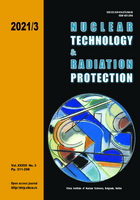
STUDY OF MATHEMATICAL FUNCTIONS TO FIT DETECTOR EFFICIENCY CURVE IN GAMMA RAY ENERGY RANGE FROM 59.54 keV UP TO 1408.01 keV

Vol.
XXXVI, No. 3, Pp. 211-298
September 2021
UDC 621.039+614.876:504.06
ISSN 1451-3994
Pages: 224-233
Authors: Abouzeid A. Thabet, Bohaysa A. Salem, and Mohamed S. BadawiAbstract
Recently, there have been several significant improvements in the area of the radiation detection system and its instruments, especially those using scintillation or semiconductor gamma ray detectors. Scientists and technicians are interested in studying this progress, which can be useful for the detector's operation and its basic properties, such as energy, shape, and efficiency calibration. In this work, an extended study of various mathematical formulas was conducted to obtain the efficiency best-fitting function, that covers the measured values from low to high energy regions. They can be used to represent the efficiency of a high-purity germanium detector in the regions where accuracy and maximum speed in optimizing the calibration process are very important for gamma spectroscopy. Determination of the activity of environmental samples mainly depends on the efficiency calibration curve of the detection system. The gamma ray energy in the range from 59.54 up to 1408.01 keV used in this work was obtained by using a set of standard radioactive gamma ray sources of certified intensity. The current data analysis shows that most of the mathematical formulas, which represent the fitting curve for the detector full-energy peak efficiency, were quite agreeable with the experimental results.
Key words: mathematical formula, full-energy peak efficiency, fitting process, gamma ray detector, radioactive point source
FULL PAPER IN PDF FORMAT (1.28 MB)